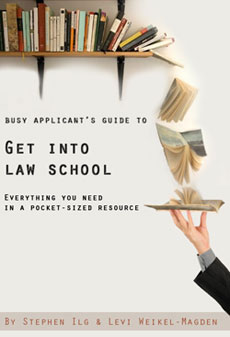Book Review: Busy Applicant’s Guide to Get into Law School
- by
- Jan 28, 2012
- Admissions, Odds and Ends
- Reviewed by: Matt Riley


Another book review? You bet your ass another book review.
This time we’ve got Busy Applicant’s Guide to Get into Law School: Everything You Need in a Pocket-Sized Resource, which is available now for Kindle on Amazon. The book checks in at 133 pages and was written by former LSAT instructor Stephen Ilg and former Yale law career counselor Levi Weikel-Magden. It’s a breezy but informative read that, for anyone interested in a JD, would be an adequate next step in research after a few hours on Google.
 Moreover, Get Into Law School would be an ideal read for a student who just completed his or her first year of college and was considering law school. The book provides a thorough summary of the requirements and expectations to get into law school, and when the time comes to begin the admissions process, he or she could dig it out and follow its guide for a refresher on the next course of action.
Moreover, Get Into Law School would be an ideal read for a student who just completed his or her first year of college and was considering law school. The book provides a thorough summary of the requirements and expectations to get into law school, and when the time comes to begin the admissions process, he or she could dig it out and follow its guide for a refresher on the next course of action.
The book outlines the entire timeline of the admissions process, from what steps to take as an undergrad, how rolling admissions works, the importance of a student’s LSAT score, GPA, essays and letters of recommendation, the concern with writing an addendum, and the time after applying.
Ilg and Weikel-Magden’s goal was to provide the pros and cons of every stage of the admissions process and let readers decide for themselves which path to take, but the authors never hesitate to recommend their preference. For example, after laying out both sides of the “should I apply for an early decision” argument, the authors ultimately recommend that no, you probably shouldn’t. The only scenario in which you should apply for early decision, they say, is if you are certain of the school and you consider the school a reach.
The authors focus a lot of their energy (as they should) on the LSAT and personal statement. The chapter on personal statements, the longest chapter in the book, is ripe with information and advice — perhaps a reflection on Ilg and Weikel-Magden’s expertise. The duo emphasizes that students should constantly edit their personal statements so that it gives four pages of information in two. Although a it won’t singlehandedly get a person into law school, one’s personal statement is crucial in that it can (and should) be a law school’s most valuable tool for really seeing a candidate as more than a name and numbers.
As for the LSAT, Get Into Law School acknowledges that a student’s score is the most important piece of an application (even though law schools won’t admit it) before giving a simple outline of what is on the exam. For those serious about achieving their most potential on LSAT test day, the book recommends students take an LSAT prep course. The book even breaks down the features of four top LSAT prep companies, and Ilg and Weikel-Magden, the wise men that they are, rank Blueprint right up there with the best in the business.
Too kind. Too kind.
Other notable nuggets from Get Into Law School:
– On activities to participate in during college to help get into law school: “Anything alcohol or drug-related or anything overtly controversial should probably not be included.”
– You want your final LSAT score, along with all other pieces, completed by Nov. 30.
– On us: “Blueprint is one of the more exciting companies in the industry right now.” (Woo!)
– On letters of recommendation: “[They] rarely make someone’s application but have the potential to break one” and “The story in your letter is much more important than the person who writes the letter.”
– On addendums: “You don’t want to tell law schools you are terrible at tests.”
Search the Blog

Free LSAT Practice Account
Sign up for a free Blueprint LSAT account and get access to a free trial of the Self-Paced Course and a free practice LSAT with a detailed score report, mind-blowing analytics, and explanatory videos.
Learn More
Popular Posts
-
logic games Game Over: LSAC Says Farewell to Logic Games
-
General LSAT Advice How to Get a 180 on the LSAT
-
Entertainment Revisiting Elle's LSAT Journey from Legally Blonde








